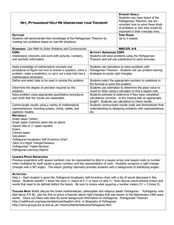Curated OER
Hey, Pythagoras! Help Me Understand Your Theorem!
Learners explore the Pythagorean Theorem. In this math lesson plan, pupils solve problems using the Pythagorean Theorem. They select the appropriate numbers to substitute in the formula to solve problems.
Curated OER
Flying with Pythagoras
A lengthy narrative about Pythagoras and his students precedes an activity in which your young mathematicians practice using the Pythagorean theorem to solve three problems about flight and distance. Answers are provided.
Curated OER
Proving Pythagoras
Students prove the theorem of Pythagoras. In this Pythagorean Theorem instructional activity, students define the different parts of a right triangle. They use the Pythagorean Theorem to solve for the missing sides and angles of a right...
Curated OER
The Search for Pythagoras' Treasure
Students identify and define properties of triangles. In this geometry instructional activity, students identify the missing sides and angles of right triangles. They use the rules of the Pythagorean Theorem to solve their problems.
Curated OER
Investigating the Idea of Sin
Fifth graders use sin to solve problems involving right-angled triangles, Solve equations of the form sin(++) = a, for a between -180++ and 360++. They State and graph the value of sin(++) in special cases. They describe some of the ways...
Curated OER
Investigating Trigonometric Ratios Through Similar Right Triangles.
49Young scholars investigate the properties of right triangles. In this geometry lesson, students differentiate between similar and congruent triangles. They use the Pythagorean Theorem to find the missing angles and sides.
Curated OER
Plenty of Pythagoras
Using a twelve foot knotted rope, learners form a 3-4-5 right triangle. Following a discussion of observations about the lengths of the sides of the triangle, students use grid paper, scissors and a centimeter ruler to draw and measure...
Curated OER
Investigating the Idea of Cos
Fifth graders use cos to solve problems involving right-angled triangles. They solve equations of the form cos(++) = a, for a between -180 and 360 degrees. They state the value of cos(++) in special cases and graph y = cos(++).







